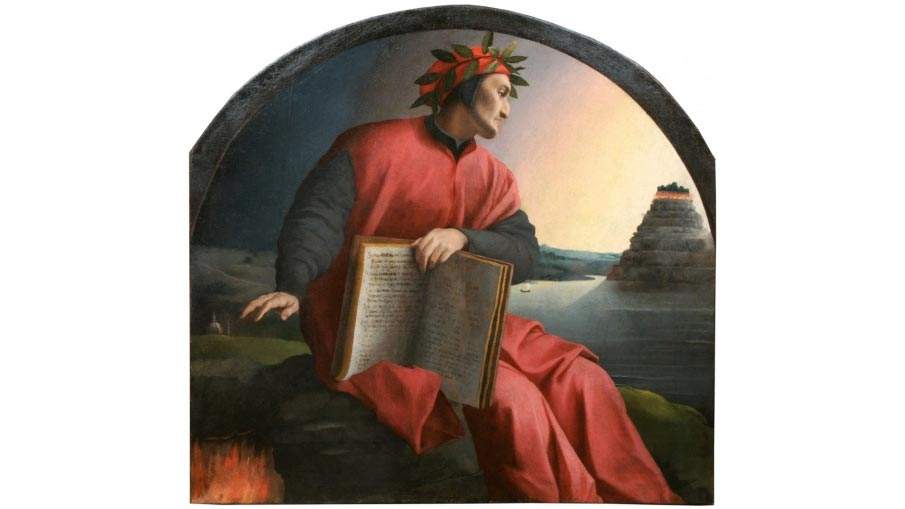Florence, Bronzino's celebrated allegorical portrait of Dante on display
It is one of the most famous portraits of Dante Alighieri (Florence, 1265 - Ravenna, 1321), even though it was made more than two hundred years after his death: it is the allegorical portrait painted by Bronzino (Angelo di Cosimo Tori; Florence, 1503 - 1572), is privately owned, but from October 11 to December 31 it can be admired by the public at the Certosa del Galluzzo in Florence on the occasion of the exhibition ...con altra voce ritornerò poeta. Bronzino’s Portrait of Dante at the Certosa in Florence, a project conceived by Antonio Natali, former director of the Uffizi, together with Alessandro Andreini, and organized under the auspices of the Archdiocese of Florence by the Community of San Leolino, the Opera di Santa Maria del Fiore and the Opera di Santa Croce. The exhibition thus offers the exclusive display of the painting executed in 1532-1533 by Bronzino and coming from a private Florentine collection.
The Allegorical Portrait of Dante will be arranged at the back of the Pinacoteca della Certosa, which on the left side also houses Pontormo’s five frescoes (painted around 1523) depicting Scenes from the Passion, in the realization of which Bronzino himself collaborated, while a plague epidemic was spreading in Florence. Also on view in the Pinacoteca room are the small-scale copies executed on canvas by Jacopo da Empoli and other Florentine painters from the Accademia delle Arti del Disegno around 1582. The exhibition is therefore an opportunity to admire a work that is rarely seen, since it comes from a private collection, in a historically relevant setting. For curator Antonio Natali, the exhibition constitutes “a way to celebrate Dante by recalling with him illustrious artists who were passionate admirers of him in the 16th century.”
The historical events of Bronzino’s Allegorical Portrait, a lunette published in 2002 as Bronzino by art historian Philippe Costamagna, and which in 2015 was exhibited for a period in Room 65 of the Uffizi Gallery, are linked to an episode reported by Giorgio Vasari in The Life of Bronzino. Upon his return from Pesaro, the Florentine painter received a commission from Bartolomeo Bettini for portraits of the three fathers of Italian literature, Dante, Petrarch and Boccaccio, to be placed in the lunettes of a room in his home. The commission to Bronzino, however, also had a political flavor: both Bettini and his friend Michelangelo Buonarroti were in fact heavily involved in defending the Republic against the tyranny of Duke Alessandro de’ Medici, and Canto XXV of Paradise, which can be read on the book held up by Dante eager to return from exile, particularly fits the political fortunes of the Bettini family. It should be noted that Jason Houston’s essay in the catalog is devoted precisely to the relations between Canto XXV of Paradiso and the work painted by Bronzino for Bettini.
The overall significance of Bettini’s project is described in the Life of Pontormo, who executed a panel with Venus and Cupid for that same room, on a cartoon by Michelangelo. Of the portraits of the three great men of letters, the only one known to date is that of Dante and it is known precisely from the work in the Florentine collection that will be exhibited at the Certosa, which also has a replica from Bronzino’s workshop preserved in the Kress Collection of the National Gallery of Art in Washington. From this portrait of Dante is derived the woodcut face that stands out on the frontispiece of the Divine Comedy published by Francesco Sansovino in 1564.
As for the choice of site, the Certosa del Galluzzo, which was created at the behest of Niccolò Acciaiuoli between 1342, the year in which the entire project was outlined, and 1356, when by then the main building was almost completed), was in ancient times flanked by a palace for the cultural and religious education of young Florentines turning to humanistic studies. Niccolò Acciaiuoli, who was a cultured man, had chosen as his procurator Giovanni Boccaccio who, like Francesco Petrarch, was a friend of his; and on the relations between the destinies of Dante and Acciaiuoli insists precisely the essay by Alessandro Andreini. For this reason the Certosa was chosen as the place to host the portrait as part of the celebrations for the seventh centenary of Dante’s death. And again, the decision to exhibit this portrait by Bronzino was determined not only by its very high quality, but also by the strong relations that bound the painter (he, moreover, also a poet, now Bernesque and now Petrarchan) to the Certosa.
The exhibition catalog, published by Feeria and Polistampa, has also been produced for the occasion, with editorial care by Alessandro Andreini and essays not only by Andreini himself but also by Andrea Baldinotti, Monica Bietti, Jason Houston, Carmelo Mezzasalma and Antonio Natali. The exhibition will be open every day (except Monday and Sunday mornings) from 10 a.m. to 12 p.m. and 3 p.m. to 6 p.m. Admission 5 euros; the ticket also includes a guided tour of the Charterhouse. For more information you can visit the Florence Charterhouse website.
 |
| Florence, Bronzino's celebrated allegorical portrait of Dante on display |
Warning: the translation into English of the original Italian article was created using automatic tools. We undertake to review all articles, but we do not guarantee the total absence of inaccuracies in the translation due to the program. You can find the original by clicking on the ITA button. If you find any mistake,please contact us.



























